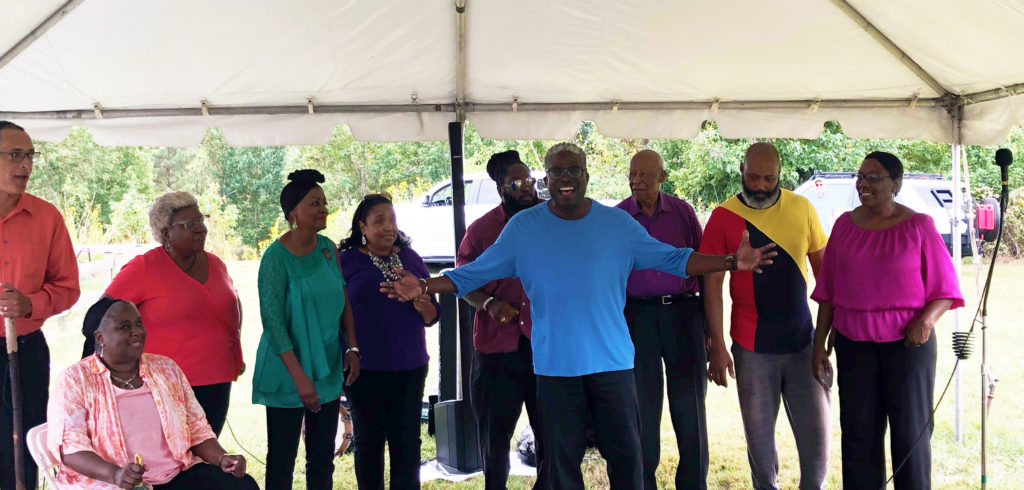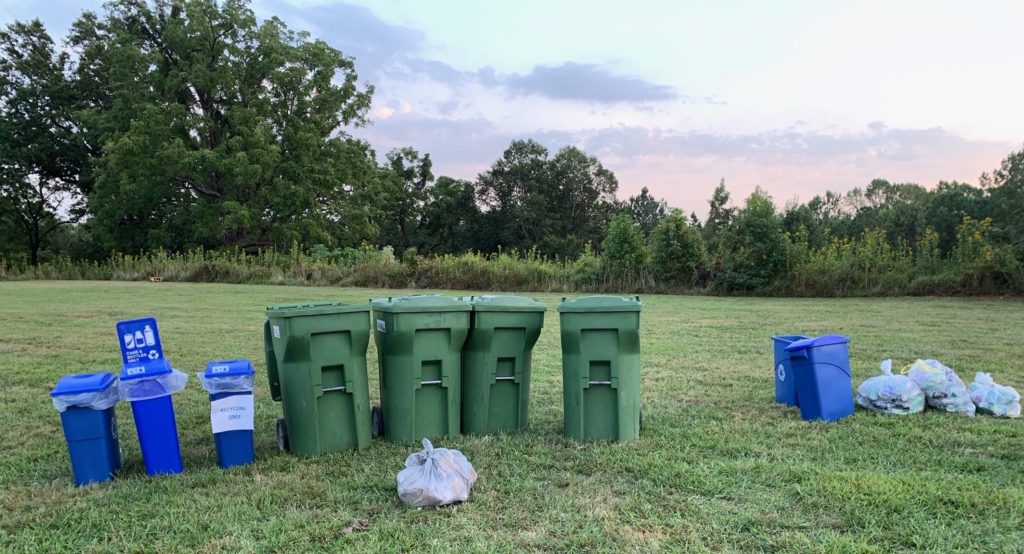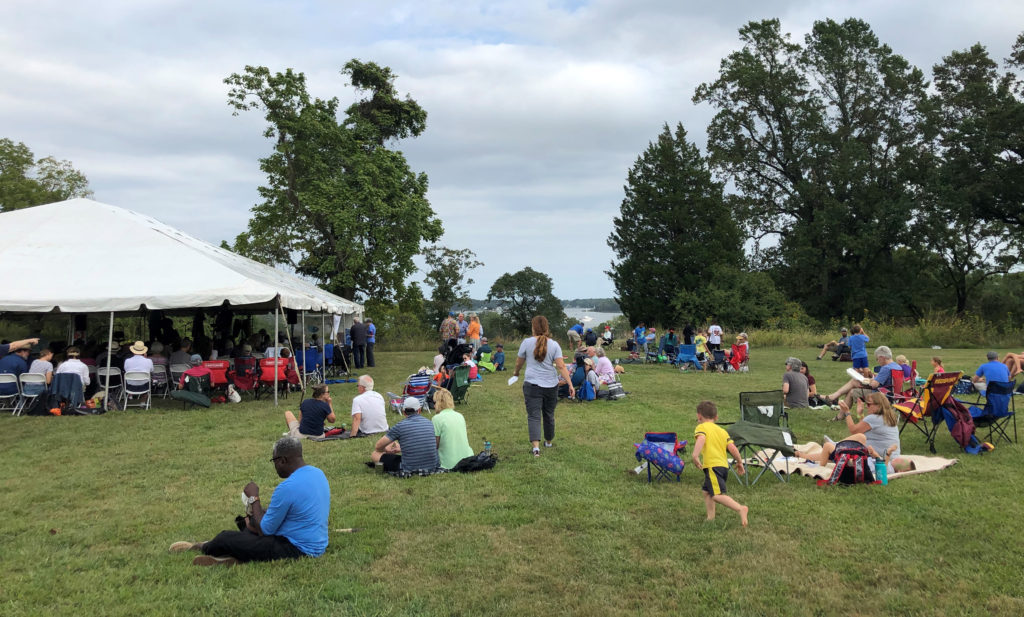
A capella group Washington Revels Jubilee Voices, at the Chesapeake Music Festival.
(Credit: Kristen Minogue/SERC)
by Sarah Wade
This article originally appeared in the November issue of the Smithsonian’s Sustainability Matters newsletter.
One small bag that could fit into an office-sized trash can. That’s all the waste that remained after a concert with more than 300 attendees, over 50 staff and volunteers, eight performing groups and four food vendors. Surrounding it, eight recycling containers and four composting bins waited for pickup. By and large, the first Chesapeake Music Festival achieved its goal of near-zero waste, to the exhausted but happy relief of its organizers.
Months of effort went into that lone trash bag: working with vendors, buying supplies, and encouraging the public to bring their own water bottles to cut down on single-use plastics.
Part of the Smithsonian Year of Music, the Chesapeake Music Festival on Sept. 14 included performances from Don Shapelle, Jeff Holland and That West River Band, Washington Revels Jubilee Voices and other folk singers from around the Bay. But when the Smithsonian Environmental Research Center (SERC) and the Arundel Rivers Federation teamed up to hold it, they had an even loftier target: make it zero waste.
The Smithsonian already has an institution-wide initiative to promote good environmental practices. And the Smithsonian Folklife Festival, an event 1,000 times the size of the music festival, had set the bar high. Earlier in the year, Dr. Eric Hollinger, archaeologist and Smithsonian sustainability
advocate responsible for designing the eco-friendliness of the Folklife Festival’s waste diversion, had given a talk at SERC impressing the need to be knowledgeable about the realities of recycling. Finally, and perhaps most importantly, SERC and the Arundel Rivers Federation’s missions are inherently environmentally conscious. With all of that in mind, festival staff—a small but dedicated team from SERC and Arundel Rivers—set out to explore what it would take to make zero waste a reality.

The small gray trash bag (center) that remained after the Chesapeake Music Festival.
(Credit: Sarah Wade/SERC)
The first big steps were with the food vendors. It was important to take a proactive approach when it came time to choose which food trucks to invite. The festival coordinators found two—The Green Bowl and Goganics, both hailing from Baltimore—already committed to sustainable practices: using compostable materials, locally sourcing produce, and (in Goganics’ case) even running the truck with their spent fry oil. From a practical standpoint it made things easier. But it also sent a message to festival-goers that the Chesapeake Music Festival was serious about making the best choices possible for the environment.
Aside from food trucks, there were other food vendors there, including a small local community center, with whom festival planners worked to buy compostable supplies. Being sustainable isn’t always cheap, especially for a small business. For example, one case of 1,000 16-ounce compostable clear cold cups can cost $89. That same case in plastic costs just $52. It can be difficult for a business to be able to spend money on these items when they also must measure profit. To ensure a zero-waste day, the festival helped them procure these items. It was especially rewarding to answer questions about sustainability, how to waste less, and other best practices. Even if using compostables isn’t feasible for some businesses in the long run, finding new ways to reuse items and cut down on single-use plastics can be accomplished with a little creativity and, when done smartly, can lead to savings.
Another important component of the event was creating a single waste zone. Because the music festival area was so small, only a single resource recovery station was necessary (unlike the Folklife Festival, which required multiple stations peppered throughout the grounds). Manned by a team of volunteers, the waste tent sheltered recycling bins, composting bins, and the single office-sized trash can. The volunteers were not only there to monitor the streams of disposables and prevent materials getting mixed up, but also to answer questions about composting, recycling, and sustainability. These volunteers were vital to the success of the day. Because SERC doesn’t have on-site composting capabilities, the center contracted out with Veteran Compost—a local business which provides multiple levels of composting support. The bins arrived on Friday and were picked up on Monday, removing over 250 gallons of compostable organic material.

Families listen to music at the Chesapeake Music Festival, on SERC’s hilltop overlooking the Rhode River. (Credit: Kristen Minogue/SERC)
In support of the One Smithsonian Plastics Reduction Initiative, the organizers encouraged attendees to bring their own refillable water bottles and established a central “water zone” where attendees could refill for free from large jugs. The organizers also borrowed one of the water stations from the Folklife Festival. Planners worked with food vendors and persuaded them to sell canned beverages in lieu of plastic bottled water. Everyone was enthusiastic and cooperative, which directly contributed to the success of the event.
While the Chesapeake Music Festival might not become an annual event, SERC and Arundel Rivers showed that with dedication and planning, it was possible for a small unit to follow the example set by the Folklife Festival and throw a large-scale event with sustainability at the forefront. Both organizations are extremely proud of the day’s success, and are grateful to every team member who helped make it happen!

